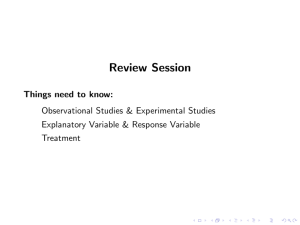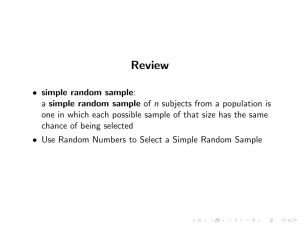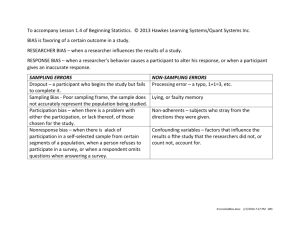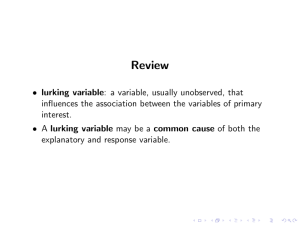Improving Trust Estimates in Planning Domains with Rare Failure Events
advertisement
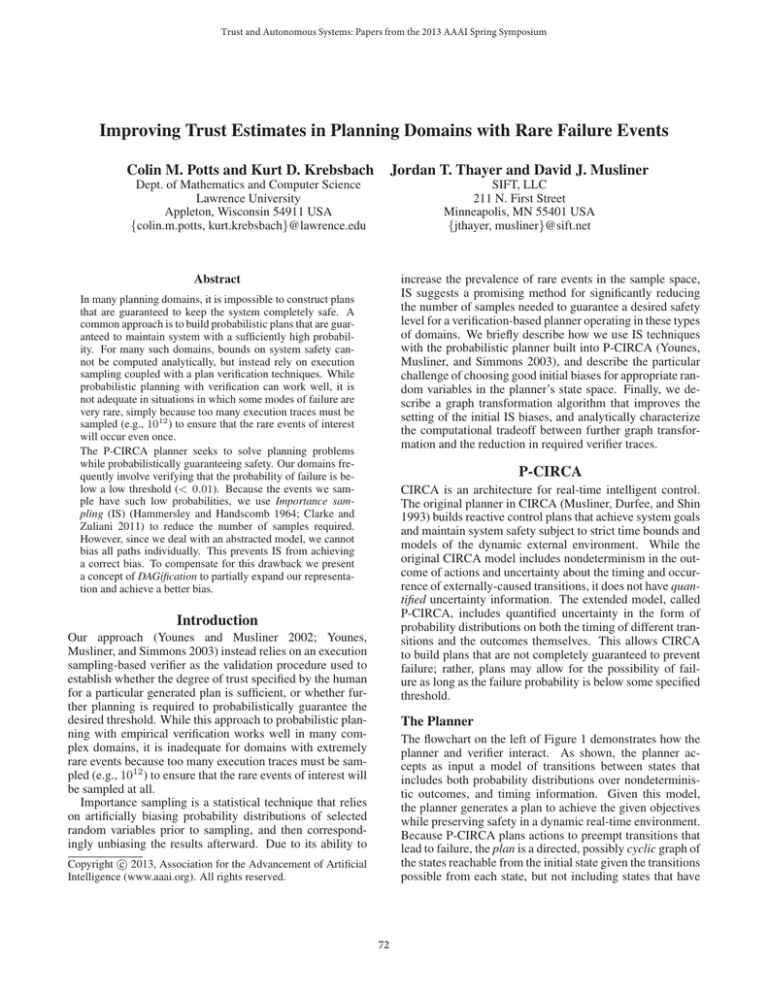
Trust and Autonomous Systems: Papers from the 2013 AAAI Spring Symposium
Improving Trust Estimates in Planning Domains with Rare Failure Events
Colin M. Potts and Kurt D. Krebsbach
Jordan T. Thayer and David J. Musliner
Dept. of Mathematics and Computer Science
Lawrence University
Appleton, Wisconsin 54911 USA
{colin.m.potts, kurt.krebsbach}@lawrence.edu
SIFT, LLC
211 N. First Street
Minneapolis, MN 55401 USA
{jthayer, musliner}@sift.net
Abstract
increase the prevalence of rare events in the sample space,
IS suggests a promising method for significantly reducing
the number of samples needed to guarantee a desired safety
level for a verification-based planner operating in these types
of domains. We briefly describe how we use IS techniques
with the probabilistic planner built into P-CIRCA (Younes,
Musliner, and Simmons 2003), and describe the particular
challenge of choosing good initial biases for appropriate random variables in the planner’s state space. Finally, we describe a graph transformation algorithm that improves the
setting of the initial IS biases, and analytically characterize
the computational tradeoff between further graph transformation and the reduction in required verifier traces.
In many planning domains, it is impossible to construct plans
that are guaranteed to keep the system completely safe. A
common approach is to build probabilistic plans that are guaranteed to maintain system with a sufficiently high probability. For many such domains, bounds on system safety cannot be computed analytically, but instead rely on execution
sampling coupled with a plan verification techniques. While
probabilistic planning with verification can work well, it is
not adequate in situations in which some modes of failure are
very rare, simply because too many execution traces must be
sampled (e.g., 1012 ) to ensure that the rare events of interest
will occur even once.
The P-CIRCA planner seeks to solve planning problems
while probabilistically guaranteeing safety. Our domains frequently involve verifying that the probability of failure is below a low threshold (< 0.01). Because the events we sample have such low probabilities, we use Importance sampling (IS) (Hammersley and Handscomb 1964; Clarke and
Zuliani 2011) to reduce the number of samples required.
However, since we deal with an abstracted model, we cannot
bias all paths individually. This prevents IS from achieving
a correct bias. To compensate for this drawback we present
a concept of DAGification to partially expand our representation and achieve a better bias.
P-CIRCA
CIRCA is an architecture for real-time intelligent control.
The original planner in CIRCA (Musliner, Durfee, and Shin
1993) builds reactive control plans that achieve system goals
and maintain system safety subject to strict time bounds and
models of the dynamic external environment. While the
original CIRCA model includes nondeterminism in the outcome of actions and uncertainty about the timing and occurrence of externally-caused transitions, it does not have quantified uncertainty information. The extended model, called
P-CIRCA, includes quantified uncertainty in the form of
probability distributions on both the timing of different transitions and the outcomes themselves. This allows CIRCA
to build plans that are not completely guaranteed to prevent
failure; rather, plans may allow for the possibility of failure as long as the failure probability is below some specified
threshold.
Introduction
Our approach (Younes and Musliner 2002; Younes,
Musliner, and Simmons 2003) instead relies on an execution
sampling-based verifier as the validation procedure used to
establish whether the degree of trust specified by the human
for a particular generated plan is sufficient, or whether further planning is required to probabilistically guarantee the
desired threshold. While this approach to probabilistic planning with empirical verification works well in many complex domains, it is inadequate for domains with extremely
rare events because too many execution traces must be sampled (e.g., 1012 ) to ensure that the rare events of interest will
be sampled at all.
Importance sampling is a statistical technique that relies
on artificially biasing probability distributions of selected
random variables prior to sampling, and then correspondingly unbiasing the results afterward. Due to its ability to
The Planner
The flowchart on the left of Figure 1 demonstrates how the
planner and verifier interact. As shown, the planner accepts as input a model of transitions between states that
includes both probability distributions over nondeterministic outcomes, and timing information. Given this model,
the planner generates a plan to achieve the given objectives
while preserving safety in a dynamic real-time environment.
Because P-CIRCA plans actions to preempt transitions that
lead to failure, the plan is a directed, possibly cyclic graph of
the states reachable from the initial state given the transitions
possible from each state, but not including states that have
Copyright c 2013, Association for the Advancement of Artificial
Intelligence (www.aaai.org). All rights reserved.
72
1-p
S0
p
Sfail
Figure 2: The original model.
1-p
1-p
S0,t=1
S0
p
p
S0,t=2
p
1-p
1-p
!
S0,t=k
p
Sfail
1-p
Figure 3: The original model with paths expanded out to
length k.
Without importance sampling, the sequential probability ratio test (SPRT) (Wald 1945) is used after each simulation
to determine whether enough samples have been run to halt
simulation and return an overall result. This result will be to
accept the plan if the simulations have determined that the
probability of failure of the plan is less than the specified
safety threshold (pf ail < ✓).
Figure 1: P-CIRCA planning and verification both without
(left) and with (right) importance sampling.
been made unreachable by planned preemptive actions. As
noted, cycles are common in the graph for a variety of reasons: the world can undo things we want to achieve; actions
can probabilistically fail to achieve postconditions and cause
a self-loop. In such cases, the agent can essential remain or
return to the “same state” but with some time having run off
of the state’s “dwell time” clock. It is for this reason that
the world model of the probabilistic extension corresponds
to a generalized semi-Markov process (i.e., the dwell time in
a state can influence which transitions are possible out of a
state). In this paper we will introduce technique for reducing
the impact of these cycles on the verification step, a process
we call DAGification. We will see shortly how eliminating at least some of these same states with different clocks
through DAGification results in a better graph in which to
employ importance sampling techniques.
Importance Sampling
Statistical verification techniques work much more efficiently when sampling events with high probabilities. Importance sampling was developed to take a domain with very
low-probability events and bias the probabilities of those
events so that the low probability events can be sampled at
a high probability. Through principled unbiasing of the results obtained during simulation, it is possible to derive the
desired probabilities of hypothesis relevant to the original
model. The biasing works by selecting some set of the probabilistic transitions in a model and assigning them new probabilities. (Note that the size of this selected set of transitions
is critical to leveraging importance sampling to significantly
reduce the number of samples, as we will discuss shortly.)
Then when a sample is drawn we compute the ratio of the
true probability of the trace f (X) over the biased probability
f⇤ (X). We then take the mean of these ratios which gives
us an estimate of the probability of the event (Hammersley and Handscomb 1964). Because we are sampling rare
events much more often, we often require far fewer samples
to prove or disprove the original hypothesis.
The Verifier
In earlier work, Younes and Musliner (2002) presented a
procedure for probabilistic plan verification to ensure that
heuristically-generated plans achieve the desired level of
safety. With this approach, we attempt to minimize verification effort while guaranteeing that at most a specified proportion of good plans are rejected and bad plans accepted.
As shown on the left of Figure 1, the Monte Carlo simulator generates a set of random variables which constitute
the dynamics of the environment for a single execution path.
The plan is then executed in this environment to determine
a single success or failure outcome. Given enough sample
paths, the verifier can guarantee that at most a specified proportion of good plans are rejected and bad plans accepted.
DAGification
As in most search problems, the state space is described
implicitly via action and event descriptions. In the course
of planning appropriate actions, P-CIRCA will expand portions of the reachable state space; however P-CIRCA will
not explicitly “DAGify” cycles for which it can adequately
plan without doing so. Such a situation is shown in Figure 2.
P-CIRCA will attempt to plan the best action it can from
73
1-pb
S0,t≥k
pb
the computation saved by requiring fewer samples due to
improved importance sampling.
DAG
Sfail
p bk
DAGification vs. Sampling
Sfail,t=k
We would like the expected decrease in samples to be
asymptotically greater than the work required by the DAGification process. Suppose our model – DAGified to depth k
– has an average branching factor of b. Then DAGification is
simply a breadth first search to depth k, and thus will expand
bk nodes. In terms of memory, we must then create a new
model with a new state/transition pair for all fringe nodes of
the search. This leads to the observation that ideally k is less
than logb of the expected decrease in the number of samples.
ploop
Original
S0,t=0
p b1
Sfail,t=1
p b3
p b2
Sfail,t=3
Sfail,t=2
Analytical Results
Figure 4: The partially-DAGified model.
We now describe two predictive functions for this simple domain that estimate the expected probability of failure. The function M axI gives us the largest length of
a path that will be sampled if we take n samples in the
given plan. To determine this number, we say that no path
whose probability is less than x will be sampled.
is a
function that depends on the same variables as M axI (i.e.
(p⇤ , n, x), (pl , pf , k, n, x)). This dependency is notationally suppressed below for brevity. Equation 2 describes
the expected failure rate for plain IS while Equation 3 describes the version with the additional DAGification step.
We compute the analytical probability of failure after T time
steps in Equation 1.
state S0 which may only probabilistically preempt the transition to Sf ail ; however, the planner itself might not need to
expand states forward from S0 to determine that best action.
Although planning might not always require it, DAGification of cycles provides more transitions to individually bias,
and consequently provides more opportunities to improve
the initial biases upon which more efficient importance sampling depends. If there is a cycle, we might be unable to express the optimal bias for IS and obtain a zero-variance estimator. This is not true for directed acyclic graphs (DAGs),
in which case we can always express a zero-variance estimator. While it can sometimes be prohibitively expensive to
fully-DAGify the cycle, partial DAGification can, as we will
show, get us significantly closer to zero-variance.
Beginning with an implicit description of the state-space
model we seek to expand this model to enable greater control
of importance sampling. Ideally we would like to bias the
probabilities of individual traces (as opposed to individual
transitions), which would theoretically allow us to achieve
an optimal bias, and obtain maximum benefit from importance sampling. We now describe a two-step approach that
makes this possible, at least out to length k, at which point
the computation may no longer be justified for the expected
benefit.
The first step of DAGification involves taking the statespace model as shown in Figure 2 and expanding all paths
from the initial state out to length k, as shown in Figure 3.
We then introduce a new initial state, S0,t=0 . Let Y equal
the set of all paths who either reach a sink state in less than
k steps, or any path of length k from S0,t=0 . The process
works by taking each y 2 Y , and adding a single transition
from S0,t=0 to Send(Y ) . Here we use Send(Y ) to denote the
state where path y terminates. In the example we use, these
paths all end in Sf ail after a certain number of steps (i steps),
so we have Send(Y ) = S0,t=i for i = 1..k, and one additional path that ends at S0,t k . The transition model from
this point remains the same and corresponds to the original,
unDAGified portion of the model, except with timing characteristics of S0,t k adjusted to account for the dwell time of
the states in the DAGified portion. We now analyze the relationship between this extra DAGification computation and
pf ail
=
pIS
=
pDAG
=
1 (1 p)T
⌘
1⇣
1 (1 p)M axI(p⇤ ,n,x)
⌘
1⇣
1 (1 p)M axI(pl ,pf ,k,n,x)
(1)
(2)
(3)
Given these probabilities, we now define functions to express the expected error. Each error is divided by pf ail to
convert it to a percentage.
pf ail pIS
Err[pIS ] =
(4)
pf ail
pf ail pDAG
(5)
Err[pDAG ] =
pf ail
The graph in Figure 5 shows the corresponding error rates
for values of 0.1, 0.5, and 0.9 for each of p⇤ (plain IS) and
pf (DAGified IS). The number of samples, n, varies along
the x-axis from 50 to 500. We plot the error rate without
DAGification (Err[pIS ], from Equation 4 – as shown in the
top three curves – against the error rate of IS with DAGification (Err[pDAG ], Equation 5). The biased probabilities of
transition to failure (from the original model) are denoted p⇤
for plain IS and pf for DAGified IS. In both cases, the values
x = .1, p = .0001, and T = 200 remain constant, while p⇤
and pf each take on the same three values as shown. The
additional parameters pertinent to IS with DAGification are
ploop = .5 (as shown in Figure 4), and k = 100 (the maximum depth of allowable graph expansions).
We note that IS with DAGification results in significantly
lower error rates in all three cases. Since (3) depends on
74
! error
1.0
p# "0.9
p# "0.5
p f "0.9
p f "0.5
0.4
p f "0.1
100
200
300
(6)
B (path)
=
|path|
⇧i=0 B ⇤ (ai ),
(7)
K ⇤ (path)
=
⇧i=0
400
|path|
P (ai )
.
B ⇤ (ai )
(8)
Thus, if there exists an optimal per-action bias B ⇤ (ai ) for
all actions ai in the graph, then we can compute an optimal
bias for all paths in the graph. If B ⇤ was known, we could
construct a system of equations and unknowns so that we
could attempt to solve for each B ⇤ (ai ). In an acyclic graph,
there cannot be more paths than there are actions. Thus,
the system is under constrained and there exists one or more
solutions. However, as soon as a cycle exists, there are infinitely many equations, a fixed number of unknowns, and
there is no solution to the problem.
0.2
0.0
⇧i=0 P (ai ),
⇤
p# "0.1
0.6
|path|
=
P (path)
0.8
n
500
Figure 5: Expected error rates using importance sampling
both with and without DAGification
the sum of the probabilities of the paths expanded during
DAGification (1 ploop ), the lower error rates are not guaranteed to hold for every such choice of ploop ; however, we
expect that for cases of interest to us the advantage would
generally be gained. For instance, with the Cross-Entropy
method as described in (Rubinstein and Davidson 1999;
Clarke and Zuliani 2011), we would expect to produce a
good bias and therefore would see results similar to these,
even if depending on our initial bias the results would be
indeterminate. DAGification thus allows such a method to
achieve better results by allowing more control over the biasing.
Optimal DAG Bias The DAG case covers two special
kinds of problems that we might want to use importance
sampling on. The first is, of course, directed acyclic graphs.
The second is any graph for which we care about events
within a finite horizon. So long as the problem has a finite horizon, we can compile any arbitrary graph down into
a DAG by unrolling all of the paths up to the length of the
horizon and rewriting that as a new DAG.
For ease of the proof, we assume that the graphs in question has special structure. Namely, they have a single initial
state and a single sink state representing the event of interest.
Without loss of generality, any DAG can have this structure.
To do this we simply add a new initial state and create actions to each original initial state (with action probabilities
based on the probabilities of the initial states themselves),
and create an action from each state of interest to a single
new sink state (these will be deterministic).
DAGs vs. Digraphs
In general, the problem is one of the structure of directed
acyclic graphs vs. generic directed graphs. So long as we
can apply the right bias to a given path, importance sampling will produce the correct solution (with low variance).
However, in P-CIRCA we have restricted ourselves to biasing actions rather than whole paths. This makes sense as we
have to restrict cost of defining the bias, and it allows us to
specify the perfect bias in many places.
Specifically, when specifying the bias over actions, we
can perfectly bias directed acyclic graphs, however we cannot bias generic directed graphs. The proof follows this line
of reasoning. In a DAG, we have a system of n equations
and n unknowns. Such a system must have at least one solution, which shows that we can compute the optimal bias
for the given problem. When we have at least one cycle in
the problem, we get an infinitely large set of equation and n
unknowns, which is not solvable.
Let the following terms be defined. B ⇤ (path) is the
optimal bias of a path. P (path) is the probability of a
path. paths refers to all paths in the DAG or digraph.
K ⇤ (path) = BP⇤(path)
(path) is the optimal computation of a sample. ↵ multiplicative error in the bias. is the error induced
by breaking samples. Let ai where i ranges from 0 to the
length of the path be the ith action along a path. P (ai ) is the
unbiased probability of that action, and B ⇤ (ai ) is the optimal bias of that action. It should be clear that:
Theorem. An optimal bias can be described when performing importance sampling on a DAG with probabilities and
biases ascribed to single edges in the DAG.
Lemma 1. Each path in a DAG has at least one edge which
only exists in that path.
Lemma 2. A DAG contains at most |E| unique paths
through it, where E is the set of all edges in the DAG.
Lemma 3. DAGs of interest for importance sampling also
contain at least one path through them.
Proof. Let D be a DAG consisting of the vertexes V and
edges E. We will say that the edges have probability ai ,
where i represents the ith member of E. The biases for importance sampling will be described similarly, having bias
bi for the ith edge. We will find it useful to discuss the paths
through the DAG to the event of interest, and we will refer to them as p being members of P . Let K be the actual
probability of the event of interest.
The DAG represents multiple possible events in sequence,
some of which we are interested in. In fact, without loss
of generality we can remove all edges from the DAG which
cannot lead to an event of interest. As a result, the sum of the
75
weights on all edges in the DAG is equal to the probability
of the event in question:
⌃p2P ⇧ai inp ai = K
Starting with a linear combination of these |P | equations,
we will now derive Equation 11, thereby showing that this
equation is redundant and that the system is not over constrained:
(9)
The optimal bias for the DAG can be computed as the
solution to a set of linear equations. In fact, each p 2 P
adds an equation to the system:
⌃p2P ⇧bi 2p bi
ai
=K
(10)
bi
where i 2 p represents the inclusion of edge i in the path
p. Essentially, the product of all probabilities divided by the
product of all biases must give the actual event probability
K. This is exactly the definition of the optimal bias.
Additionally, we must add the following constraints:
=
⇧i2p
⌃p2P ⇧i2p bi = 1
=
=
U bi
= ai
(11)
1
· ⌃p2P ⇧ai 2p ai
K
1
·K
K
1
(17)
(18)
(19)
(20)
We are currently working on several improvements to this
work. First, we are in the process of conducting experiments
using P-CIRCA directly to empirically verify the analytical
results reported here. Secondly, we are generalizing the results to state spaces with cycles of arbitrary length, while
simultaneously developing a heuristic graph expansion algorithm for doing more intelligent expansion of those portions
of the state space. We are are also proving formal properties
of this heuristic DAGification algorithm to analytically derive relationships between computation required for further
graph expansion, and a corresponding computation savings
in verification sampling.
(12)
Conclusion
We are interested in the issue of trust from the perspective of
a planning agent making probabilistic safety guarantees over
a finite time span when exogenous events can lead to failure. Due to complex timing interactions, a sampling-based
verifier is used to test the safety claims made; however, if
failure events are rare, the number of samples required to
verify a given hypothesis can be prohibitive. We describe an
approach based on importance sampling (IS) to greatly reduce the number of samples required, and describe a graph
expansion algorithm that improves the initial IS biases upon
which successful IS depends with relatively modest computation. Finally, we provide an analysis of the improvement
gained, and briefly describe current work to test this analysis empirically and to extend this work to more complex
probabilistic models.
(13)
(14)
(15)
Such an assignment guarantees that any given trace
through the DAG will produce a ratio that is exactly the
probability of the event. Effectively, we have reduced our
system of |P | + 1 equations and |E| unknowns to a system
of |P | + 1 equations and |P | unknowns. A solution, should
one exist, gives us a zero variance estimator, satisfying the
requirements of the optimal bias. It remains to be shown that
this over-constrained system is solvable. We will show this
by showing that the constraint expressed in Equation 11 is
simply a linear combination of the Equations from 10:
Equation 10 be rewritten as:
⇧ai 2p ai
8p2P ⇧bi 2p bi =
k
⇧ai 2p ai
K
Current Work
This reduces Equations 10 to just finding the bias for the
first unique edge in each path, as the rest of the product will
be equal to 1 by Equation 12. In fact, the bias associated
with each first unique can be computed as:
up
=K
bp
K
1
=
bp
up
up
bp =
K
⌃p2P
17 is a linear combination of equations. 18 follows since K
is not dependent on p. 19 comes from equation 9, and 20 is
algebra.
So for any given DAG from which we might sample rare
events, there exists a set of equations which, when solved,
will provide an optimal importance sampling bias to the
problem. This set of equations is not over constrained, so
it must contain a solution.
which simply says that in the biased DAG, all probability
mass leads to the event of interest, another requirement of
the optimal bias.
We have now described a system of |P | + 1 equations
and |E| unknowns (recall that ai is given by the DAG). By
lemma 1 we know that each path contains at least one unique
edge. Because the edges exist on a path, they are naturally
ordered. As a result of the ordering and their existence, there
must be a first unique edge along a path, which we will refer
to as up , and the collection of all such edges will be referred
to as U .
We can set the bias of ever edge not in U to be exactly the
weight of the edge:
8bi 2E
=
Acknowledgments
This work was supported by both a Mellon Grant for student research at Lawrence University and by the Office of
Naval Research grant N00014-10-1-0188 via subaward from
(16)
76
Carnegie Mellon University. Any opinions, findings and
conclusions, or recommendations expressed in this material
are those of the authors and do not necessarily reflect the
views of Lawrence University, ONR, the U.S. Government,
or CMU.
References
Clarke, E. M., and Zuliani, P. 2011. Statistical model checking for cyber-physical systems. In Proceedings of the 9th
international conference on Automated technology for verification and analysis, ATVA’11, 1–12. Berlin, Heidelberg:
Springer-Verlag.
Hammersley, J. M., and Handscomb, D. C. 1964. Monte
Carlo Methods. London & New York: Chapman and Hall.
Musliner, D. J.; Durfee, E. H.; and Shin, K. G. 1993.
CIRCA: A cooperative intelligent real-time control architecture. IEEE Transactions on Systems, Man, and Cybernetics
23(6):1561–1574.
Rubinstein, R., and Davidson, W. 1999. The crossentropy method for combinatorial and continuous optimization. Methodology and Computing in Applied Probability
2:127–190.
Wald, A. 1945. Sequential tests of statistical hypotheses.
The Annals of Mathematical Statistics 16(2):pp. 117–186.
Younes, H. L. S., and Musliner, D. J. 2002. Probabilistic
plan verification through acceptance sampling. In In Proc.
AIPS 2002 Workshop on Planning via Model Checking, 0–
7695. AAAI Press.
Younes, H. L. S.; Musliner, D. J.; and Simmons, R. G. 2003.
A framework for planning in continuous-time stochastic domains. In Proc. Thirteenth International Conference On Automated Planning And Scheduling, 195–204. AAAI Press.
77


